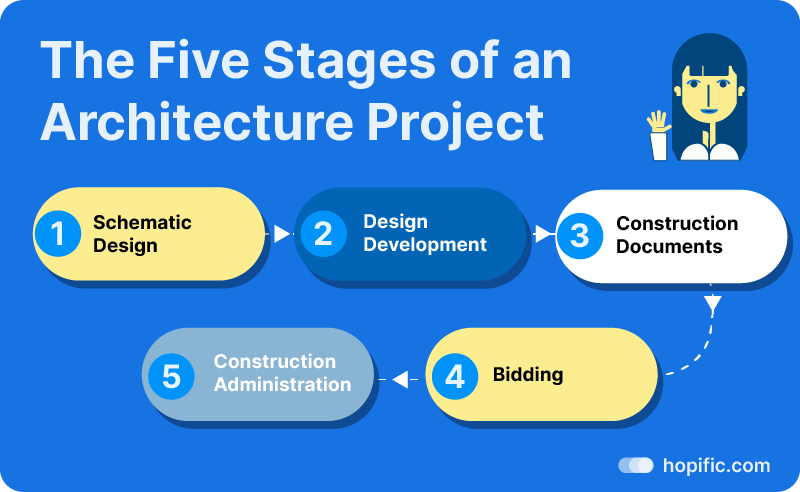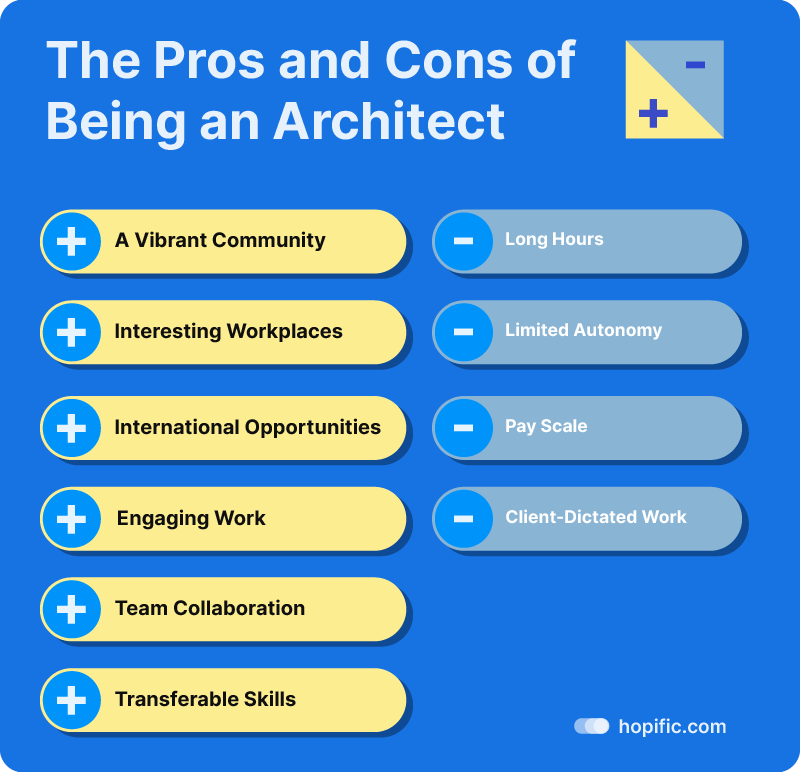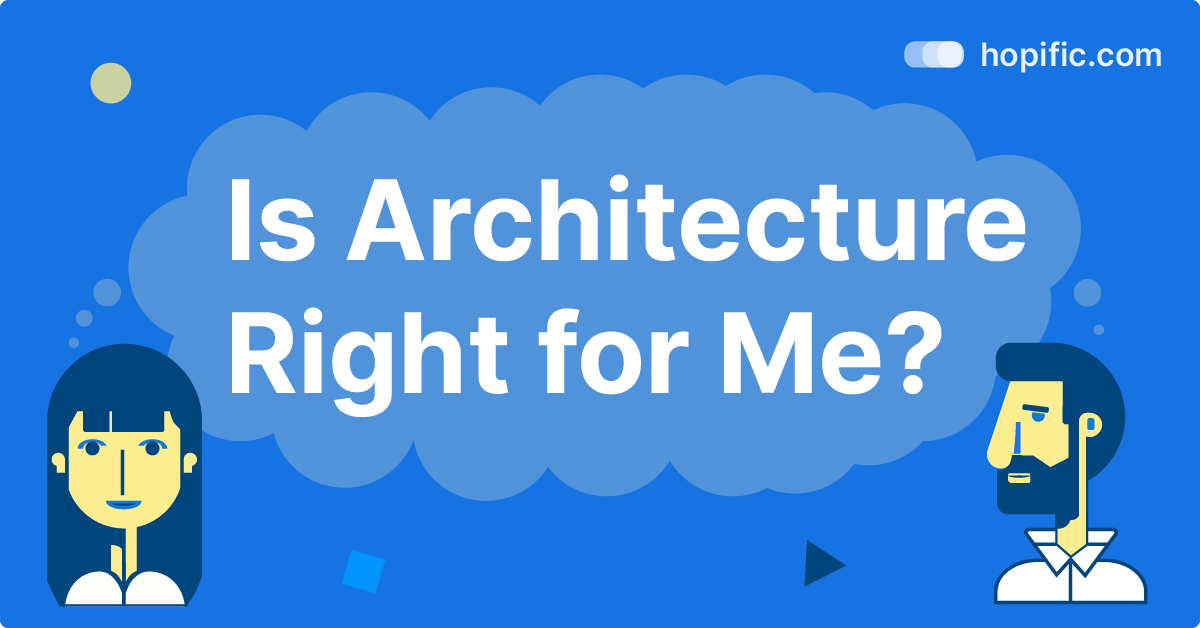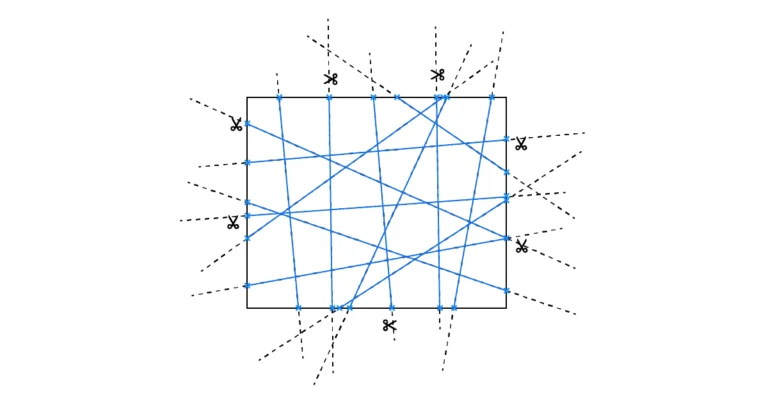Are you standing at the crossroads of deciding whether architecture is your true calling? Or perhaps, you’ve already embarked on the journey and now find yourself questioning if it’s the right path for you?
How will you know if architecture is right for you? In this guide I’ll use my almost two decades of experience studying and working in architecture to help you answer that question.
Entering the architectural profession is a big commitment. From yearslong study to apprenticeship and architect registration examination (ARE), it’s marathon rather than a sprint, so it’s all the more important to be certain that architecture is right for you.
Well, you’re in the right place. I’ve put together this comprehensive guide to help you explore the world of architecture and make an informed decision about whether it’s the perfect career match for you.
Let’s get started!
Being an Architect: Dispelling Architectural Stereotypes
Before I started studying architecture, I had next to no idea of what it entailed.
The reason I started to study architecture is that I had liked the buildings built by old civilizations that I learned about in art history class, Greek temples in particular. And naïve as I was, I thought I would learn how to design intricate temples or be able to match the beauty and timelessness of certain churches in Italy.
I was in for a surprise! Architecture turned out to be something entirely different – and in this post I want to share in as much detail as possible, what architecture is, and what it isn’t and what I believe the necessary aptitude are to become a successful architect.
When you ask anyone what an architect does, the will confidently tell you that they design buildings. Of course. Simple right? So far so good.
When you dig deeper, they conjure up the image of a person with a big roll of plans under their arm as they visit a construction site. Is that what an architect does?
It is not so simple.
The reality is that architecture is such a diverse field, that there are countless different ways of practicing architecture and of ‘being’ an architect.
The Variety of Architecture Professions
There is the one-man practice, which is perhaps what most people envision when they think of an architect. It is perhaps closest to the stereotype mentioned above, but only a small fraction of architects start their own firm.
It is much more likely that you’ll work in an architecture firm. And there, your day-to-day looks quite different. All the stages and tasks from design to construction are now shared among specialized units or individuals within the firm. Larger buildings and masterplans are too complex to be planned by a single person – the complexity of the tasks, the amount of design production necessary, the number of stakeholders and especially the tight timeframes mean that an entire team of architects will design and plan the building. But it doesn’t stop there, there is a whole group of engineers and consultants that will assist the architects in the design.
A skyscraper for example, will involve a group of more 15 different professions at some point in the project and north of 40 people. The specialties range from structural engineering, HVAC planning, electrical planning, fire protection, façade design, building energy calculations, building information modeling, space planning, landscape design, interior design and the list goes on.
The architecture office as a whole will cover all of the architect’s responsibilities, but you as an individual within that firm are likely to specialize in a particular field.
But it doesn’t stop there. There are countless other roles architects can take on. From urban design, to heritage preservation, from computational design to sustainability expert, from consulting for real estate developers to teaching – architecture has a near infinite number of ‘niches’ that are professions of their own.
The Two Sides of Architecture: Technical Mastery and Creative Vision

In order to know if architecture is right for you, it’s important to get to know the two sides of architecture. Fundamentally, the vast array of an architect’s tasks can be divided into two principal spheres: the technical facets of architecture, and its creative counterpart.
The technical aspects encompass the detailed drawing and planning, ensuring the building conforms to building regulations, following the legal processes necessary to get permits etc.
The creative side on the other hands is all about vision, about abstract concepts that turn into concrete – value-generating forms that create welcoming, healthy and perhaps awe-inspiring spaces. It is about sketching, designing, developing models in 3D. It is about having the sensibility to pick the right colors, the right proportions, the right formal language for a given task.
Now you may think that surely only people who excel in both make great architects?
Not really.
In practice, architects usually have a strength in one of the two areas, and they spent most of time within that domain.
If you are a formidable designer, you are likely going to be taking part in the early phases of a design project. You’ll be instrumental in giving the building its shape and identity.
Once the design direction is set, the project will transition into the hands of architects with a passion for the technical aspects of the profession. They take your design and ensure it is buildable. They develop it following the design idea the designer came up with and follow the project until its completion, from the drawing board to the construction site.
As you can see, the role of an architect can vary widely. A good predictor of a successful career in architecture is that you have a talent in one of the two main domains, and ideally, both.
Characteristics of Successful Architects
Let’s delve deeper into the core characteristics that successful architects tend to possess. The traits I’m listing are a rough guide, and you won’t need to identify strongly with all of them to have a successful architecture career. But if you resonate with these traits, it could be a solid indicator that architecture might just be your calling.
Creativity: Architecture is a creative discipline. The very essence of being an architect involves designing buildings and spaces that aren’t just functional, but also aesthetically pleasing. If you have a passion for design, an creative mind, and a keen eye for detail, this could be a promising sign.
You do not need to be great at sketching or drawing to become an architect! They are merely tools to come up with ideas. 3D modeling software and computational design tools are the contemporary way to design and an equally good way for designing creatively. As long as you can come up with ideas, no matter the medium, you’ll be fine!
Technical skills: Architecture involves more than just the artistic aspect. You don’t need to be a math wizard, but you should have a knack for the technical, be it having an intuitive understanding of physics, an natural aptitude for geometry and space, or ease in learning new software.
Problem-solving: As an architect you’ll frequently encounter design tasks that require innovative solutions. If you enjoy problem-solving, and are capable of thinking outside the box while staying grounded, architecture might indeed be a good fit for you. You could call architects “grounded visionaries”. They need to balance creativity and feasibility.
Communication: Architects are the key coordinators for any building project. You’ll frequently meet, with clients, engineers, contractors, and other professionals to present and discuss designs. Ease in communicating and interacting with people is a big plus.
Passion: Like any profession, a genuine passion for the field goes a long way. Do you feel excited when you think about creating architectural designs, or when you look at structures and spaces and think about how they’re designed? This could be a strong indicator that architecture is right for you.
If you’re finding that these characteristics resonate with you, then you’re already a step closer to knowing if architecture is the right fit for you. However, it’s not just about these traits. Let’s also explore what architects do on a daily basis in the next section to give you a more rounded view of the profession.
Inside the Architectural Process: Stages of a Project Lifecycle
Let’s now turn our attention to what the actual work looks like. To truly understand if architecture is right for you, it’s essential to grasp what the day-to-day life of an architect involves.
In the classic role of an architect, a project has four distinct project phases. They are Concept, Design Development, Construction Documentation, and Construction Administration. In the following sections, I’ll try my best to paint you a picture of what the work of an architect looks like throughout the lifecycle of an architecture project.
The starting point for a project can be a direct commission by a client or a design competition. In both cases, you receive the core parameters of the project: the site plan, the building program (split by areas, room types etc.) and the ambition that the client has for the building.
An example could be an office building on a rectangular plot in downtown L.A. with a gross floor area of 120,000sqft, comprising offices, restaurants on the ground floor and a conference center.
This information will be provided in much more detail in the so-called design brief. Once you get the brief, the project begins.

Schematic Design
The architects start developing the design. This means first understanding what the client really wants. It means studying the context, site visits and checking view angles, perspectives and the sun trajectory. Then a 3D and 2D model will be setup in CAD software. At this early stage the architects share conceptual ideas and discuss first design options. They will do massing studies and 3D-print them. The goal is to fit the building program while also creating a visually appealing architecture that creates added value for its users and its context. This phase is all about finding a creative architectural concept. It could be a special feature like lush green terracing of the building volume, oriented south for best daylight exposure. Or it could be a extremely clear geometry shape, with almost mirroring façade that reflects the city back onto itself.
If the project is a direct commission, there will be weekly meetings with the client, where concepts are presented and illustrated, and then discussed.
Architects will create visualizations (sketches, diagrams, 3D renderings) to present the project, using their graphical prowess to make the project as convincing as possible.
A strong concept will decisively influence the development of the project and if the originality of the idea is received well by the client or competition jury – the project will be selected and the design continues.
At this stage every part of the building is just rudimentarily solved. The cost estimate for example will have a margin of error of about 30%. Think of the design in the same terms – the design might still change within that margin going forward.
Design Development
The main design idea is set. Now the team of architects goes one step deeper into the planning process and adds more detail and definition to every part of the design. How many elevators? What is the final floor-to-floor height? What is the façade system? Where are the technical spaces and how much space do they need? What does the structure of the building look like and will adjustments need to be made to make the structure more efficient?
At this stage there continue to be client meetings, but many other consultants are brought on board. The engineers of various specialties have the task to calculate various loads and demands of the building in close collaboration with the architect. Information is shared, building system solutions are discussed.
The architects and engineers work with a 3D Building Information Model, which creates an integrated building model that all specialists can work on simultaneously. Plan and section drawings are set up within the software and generated automatically.
Simultaneously the building program will be developed in the plans, the façade developed 3-dimensionally, the landscape design created.
Throughout the process, design-freezes define design and coordination milestones to keep on schedule.
The design continues to be refined, what may just have been a mirror-like façade is now segmented into window panels that consider the building program, that include a way to shade the spaces behind and ways to clean the glass.
Construction Documents
The design is set and the construction documents will now be created. Multiple plans and sections highlighting different features of the building will be generated in BIM-software and fine-tuned . Every part of the building is now vetted with engineers. Everything in the design is now no longer an abstract object, but a product with particular features, by a particular producer or brand, with a particular price tag. Every door, every light is listed in tables and controlled and evaluated. At this point the project has reached the highest degree of complexity and the plans contain the highest density of information.
There are only a few smaller design decisions left to make. The final products chosen, the final colors set. Still, there are details that are being designed, to ensure the quality of the design.
Bidding
During the bidding process, construction companies will make their bids based on the construction documents you created. The architect is responsible for receiving and evaluating the bids, making sure the offers encompass everything that was asked. Finally, a construction company will be selected.
Construction Administration
The architects will deliver a big drawing package containing all the information necessary to construct the building. The project is then handed over to construction companies, who create their own plans and drawings based on the architecture plans. The architects review those plans, check them for consistency and give the green light. Some last-minute changes will need to be made as there are always some surprises once real-world techniques and problems must be considered. The architect will go on site to do site supervision, checking if everything is being executed according to the drawings, making decisions on site if needed.
This phase requires fewer architects – the architects involved in the production of the construction documentation have by now moved on to other projects.
Project length
The whole project will take from one to five years from commission to completion, depending on the scale of the project. Throughout the project the constellation of the team will change, people will join and leave. People will rotate from team to team as projects finish and new ones begin. The project manager ensures that no information is lost and on-board any new members to the design team.
As an architect you won’t follow all these phases from start to finish. That actually rarely happens. An architecture office has many projects running simultaneously, and you will need to shift your attention from project to project, which may be at different design phases.
If these responsibilities excite you, that’s another tick on your list in your quest to know if architecture is right for you. But there’s more to this puzzle. Let’s move on to discussing the education and skills required in architecture next.
Education Required in Architecture
Now, let’s talk about the necessary education and skills to become an architect. The road to becoming an architect, runs through architectural education. You’ll need a Bachelor’s or a Master’s degree in architecture.
A Bachelor’s degree in Architecture (B.Arch) usually lasts five years. It’s here where you’ll learn about architectural history, building design, and the technical aspects of architecture. After this, it’s often required to pursue a Master’s degree in Architecture (M.Arch), which further deepens your understanding of the field. This can last from 1,5 to 3 years, depending on your background. In most countries around the world you are required to gain professional experience with internships and junior architect positions to ensure you get enough experience before opening your own practice (if you choose to to do so). Additionally, licensing is a key requirement, the specifics of which can vary by location. You only need a license if you want to open your own practice.
Picking a school
When it comes to architecture schools, it’s important to understand that no two architecture programs are alike.
Remember the dichotomy between creative and technical?
The same two fronts exist when it comes to education. Some schools will focus heavily on the technical side, facilitating your entry into the profession, while they won’t push on the creative front. Other schools focus heavily on design, using cutting edge tools and technologies as well as design methods that encourage and require students to push the design frontiers beyond the known and conventional. Once again, there is no right or wrong here. Both sides are important.
By the end of their study, two graduates from the two school types mentioned above will strongly disagree on what architecture is and what it ought to do. And that’s normal since architecture is not a science – there is no one right answer. The benefit of this level of subjectivity is that there is an incredible variety of design ideologies and styles in the world of architecture. Which means that whatever your design affiliation, you’ll find your place!
If these these educational requirements sound like a path you’re willing to tread, this further supports the case that architecture could be a suitable career choice for you. However, every profession comes with its own set of pros and cons.
Pros and Cons of Being an Architect
While pursuing a career in architecture can be incredibly rewarding, like with everything, there are pros and cons to consider. While not an exhaustive list, below I’ve collected my personal take on the benefits and struggles of being an architect.

Pros:
A Vibrant Community: One of the biggest perks of becoming an architect is the opportunity to work with open-minded, creative, and passionate individuals. The architecture community is vibrant and supportive, filled with people who care deeply about their craft.
Interesting Workplaces: Architecture offices are usually not your normal office. They come in different sizes, locations and styles, but they usually have a character, all their own. Often conceived as
International Opportunities: The principles of architecture are universal. This offers the potential for global mobility. As an architect, especially as a designer, you have the opportunity to travel the world, working in different offices and experiencing diverse cultures and architectural styles.
Engaging Work: The work of an architect is often fun and engaging. The thrill of seeing a design come to life, the satisfaction of solving a complex problem, and the creative freedom make the job enjoyable and fulfilling. In addition, no two projects are the same, so work will never get boring!
Team Collaboration: Architecture is rarely a solo endeavor. You work in a team, collaborating with other architects, engineers, and professionals. This can lead to a supportive, collaborative and fun work environment.
Transferable Skills: The skills you develop as an architect are versatile and transferable. From problem-solving and project management to communication and design, these skills can prove useful in various other fields as well.
However, it’s not all sunshine and rainbows. Let’s also talk about the cons.
Cons:
Long Hours: Especially during your studies and early career, the architecture profession can demand long hours. This can sometimes lead to a challenging work-life balance. Your social circle will be mostly other architects.
Limited Autonomy: Depending on your office culture and your position, you might find yourself executing the instructions of your superiors more often than contributing your own ideas. This very much depends on the kind of office you are going to work in.
Pay Scale: While the satisfaction and accomplishment in the job can be high, the pay scale in architecture isn’t always as competitive as in some other professions.
Client-Dictated Work: While architects often see their own visions come to life, at the end of the day, architecture is a service industry. The client’s demands take precedence. Balancing your creative vision with the client’s requirements can sometimes be frustrating.
Considering these pros and cons, do you feel that the benefits outweigh the challenges? If so, this further confirms that you’re on the right track in considering architecture as your future career. However, let’s not stop here. Next, I’ll guide you through a self-assessment process to further explore if this is the path for you.
Self-Assessment: Is Architecture Right for Me?
By now you have an overview of what an architect does and how you become one. Now let’s delve into a series of introspective questions that will help you evaluate your suitability for this field. Be honest with your responses – it’s all part of the process of determining if architecture aligns with your interests, strengths, and aspirations.
- Are you creative? Do you have a knack for coming up with original ideas or finding unique solutions to problems?
- Have you ever entered a space and felt amazement? Do buildings and spaces inspire you, make you wonder about their design and construction?
- Are you an imaginative person? Do you enjoy visualizing concepts and ideas, possibly ones that don’t yet exist?
- Are you a visual person? Is the aesthetic appeal of objects and spaces important to you? Do you appreciate beauty in its many forms?
- Do you like planning something in detail and seeing it come to life as planned? Are you meticulous and derive satisfaction from bringing a thought-out plan to fruition?
- Are you good at thinking outside the box when problem-solving? Do you enjoy challenging conventions and finding innovative solutions?
- Do you like working on something until it’s just right, until all the pieces fall into place? Does the idea of tweaking and refining a project until it meets your standards appeal to you?
- Do you like ‘building’, assembling parts to create a meaningful whole? Are you intrigued by the process of taking disparate elements and bringing them together to create something cohesive and meaningful?
- Are you are a “doer” or a “dreamer”? Have you always loved making things? Or does it come easy to you to imagine and dream? Either are a sign that you have a creative drive: creating beautiful, meaningful things gets you excited.
Assessing your answers
Take a moment to reflect on your answers. If you found yourself answering ‘yes’ to most or all of these questions, that’s a strong indication that you could thrive and find fulfillment in the field of architecture. You seem to possess many of the traits and interests that align well with the profession.
If you had a mixed bag of ‘yes’ and ‘no’ responses, don’t fret. This simply means that while you have some interests and strengths that fit the architecture field, there are other areas you might need to explore or develop further. Remember, this is a self-assessment, not a definitive measure of your future success in architecture.
If you answered ‘no’ to most questions, it may be worth exploring other career options that align more closely with your interests and strengths. Remember, it’s essential to choose a career that not only suits your abilities but also one that you enjoy and find rewarding.
No matter your responses, remember that this self-assessment is just one tool in your journey to discover if architecture is right for you. Make sure to complement this with research, informational interviews with professionals in the field, and perhaps even job shadowing or internships, if possible. More on that in the next section.
Exploring Architecture Further
If you have the traits and interests necessary for the field and the outlook of becoming an architect is appealing to you, don’t stop here. There are many ways to dive a bit deeper into this field before committing.
Trial Courses: Many universities offer trial courses for those considering studying architecture. These courses can give you a taste of what studying architecture would entail and help you decide whether you’d enjoy the coursework.
Blogs and Online Platforms: Check out architectural design websites like ArchDaily and Dezeen. They offer a wide variety of articles, and project showcases. They publish articles about the latest world-class architecture and architectural trends like parametric design.
Workshops and Internships: Look out internships, or job shadowing opportunities that provide practical experience. You could reach out to local architecture firms to inquire about possible internships or even ask an architect acquaintance if you could shadow them for a day.
Use these opportunities to get a feeling for the field of architecture. Understanding if architecture is right for you is mostly about discovering your passion for the craft and the process.
Conclusion
Well, this has been quite a journey! We’ve explored the multifaceted world of architecture, from understanding what working in architecture truly entails, considering the pros and cons of the profession, to engaging in self-assessment and diving deeper with additional resources. I tried to provide you with a well-rounded overview. By now, you have all the tools to know whether architecture is right for you.
Remember, deciding if architecture is right for you isn’t a decision you make overnight. It’s a process of self-discovery, learning, and exploration. I hope this guide has served as a useful starting point in your journey. Your journey is uniquely your own, and the path you’re on is the right one as long as it leads you to a career that brings you fulfillment and joy!
Do you have any questions about the information in this guide, or would you like to share your thoughts on the topic? Feel free to comment below.
If you found this post helpful, I invite you to share it with your peers, friends, or anyone who may be contemplating a career in architecture. The journey of figuring out if architecture is right for you can often feel solitary, but by sharing resources like this, it can start a discussion and create a supportive and engaged community.
Good luck, however you decide!






